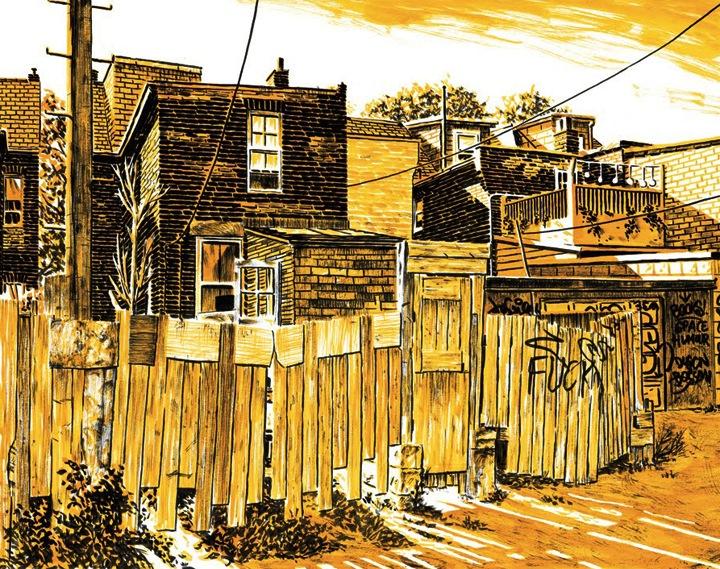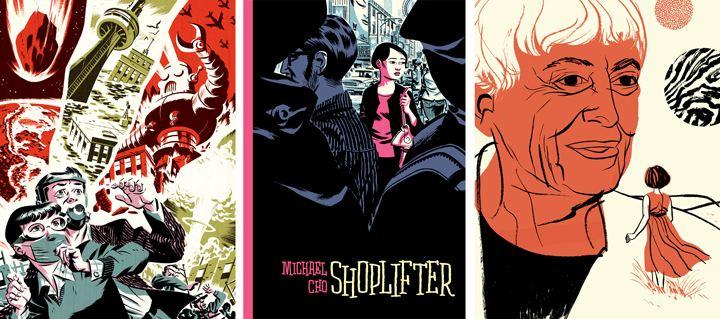Michael Cho: The Q&A
Q: Originally from South Korea, what are some of your favorite things about living and working in Toronto?
A: I’ve been living in Toronto for over 20 years and I love it here, as there’s a very large contingent of fellow cartoonists in town. It’s great to be able to run into fellow artists when you’re out for a walk or having a drink on a patio. I think Toronto has one of the greatest concentrations of cartoonists/comics creators in North America. Outside of Portland, that is; every other cartoonist lives in Portland it seems.
Q: Do you keep a sketchbook? What is the balance between the art you create on paper versus In the computer?
A: I keep a sketchbook, but I go at it in spurts. I spent 3 months last year sketching in it obsessively, even when I was horribly busy with other work. Then I went 5 months hardly opening it up. It’s a cycle and I don’t force it.
I’m not sure what the balance is for me between digital work and “traditional”. I go between the two as per the needs of a project. Usually, I know right away if something is better suited digitally or traditionally. Other times, I do it out of convenience or just a desire to change things up if I’ve been approaching it one way for too long. But even things I do completely “on the board” require some digital clean up, scanning and colour correcting.
 Toronto Back Alleys, from the book Back Alleys and Urban Landscapes, gouache and ink on
board.
Toronto Back Alleys, from the book Back Alleys and Urban Landscapes, gouache and ink on
board.
Q: What do you like best about your workspace?
A: It’s spacious and set apart from the rest of our living space. I have the entire basement of my house, which I have stocked with all the various tools, flat files and equipment I’ve collected over the years. When I’m working at night (often), I can still listen to music loudly or move about without fear of waking up my wife and daughter. It also has it’s own entrance which is nice when I want to step outside and get some air at 3am.
Q: Do you think it needs improvement, if so, what would you change?
A: I’ve gradually removed distractions over the years. I used to have a TV in there, but that’s gone. As is the videogame machine that was a holdover from younger days. I think the couch might be the next thing to go. I like it functional and as workspace, not as a hangout. But I do regret that I haven’t hung up many of the wonderful art pieces that I’ve gotten from friends over the years.
Q: What is the most important item in your studio?
A: Tricky question. I’m inclined to say my lightbox, which is this giant flat LED thing that takes up half my drawing table. Other than that, my large format scanner is handy, as is my stack of flat files for storing oversize artwork. It’s all the extra large stuff, I guess.
Q: What is your favorite part of the creative process?
A: I have a love/hate relationship with the concepting part of art. That period at the start when you’re still searching for an idea or working out quick thumbnails is exhilarating and frightening at the same time. I love it when the sea is boundless and full of potentially great drawings, but I hate it when it’s 4am and I’m staring at a pile of crumpled thumbnails, having fished fruitlessly for hours.
Q: What was the strangest or most unusual assignment you’ve taken? What made it a success or a failure?
A: I was once asked by an agency to redesign the look of sports team’s mascot which was a crazy mash-up creature that was part fish, part cougar. That was a funny challenge. My concepting phase involved me trying to work out exactly what percentage of the creature should be fish vs. mammal. Should it be a land animal with scales and fins? Should it be a fish with paws and claws? In the end, I focused on trying to express the spirit—fierceness, sleekness and agility. That made it easier to come up with something I could stand behind.
 College Street, from the book Back Alleys and Urban Landscapes, gouache and ink on board
College Street, from the book Back Alleys and Urban Landscapes, gouache and ink on board
Q: What was your favorite book as a child?
A: I really liked 1984 by George Orwell when I read it in the 7th grade. It suited my dual romantic and pessimist nature quite well.
Q: What is the best book you’ve recently read?
A: I’ll go with a graphic novel here, The Salon by Nick Bertozzi. It details the meeting and friendship between Picasso and Braque and that period in modernist art. It’s fantastic and lively and moves at a great clip.
Q: What was your first professional assignment and how did you get it? Was it a success or a failure?
A: If by professional, you mean paid, then I’d have to say that my first was a videogame title screen I drew when I was 16 for the Commodore 64. A friend made the game, knew that I could draw and was familiar with computers, and paid me the grand sum of $1000, which I proceed to blow with another friend on a trip to NYC.
But illustration-wise, my first was a series of paintings to be projected on stage for a local theatre company production of Into the Woods. An art director associated with the company and who lived in my building knocked on my door, asking if I knew any illustrators. I had no illustration experience at the time and was working as a mural painter then. I faked my way through the portfolio review and did 6 drawings in gouache for them. When I saw the play and saw that they had taken some of my little fumblings and turned them into sets and props, I gave up mural painting for good. It was way easier to sit behind a drafting table than to climb around on scaffolding at.
Q: What did you learn from that experience?
I learned what most artists starting out should learn—try everything that looks interesting. Just jump in and trust in your skills and enthusiasm to carry you over the bumps along the way. All art experience is good, even if you just learn what forms of art you really don’t want to work in again.
Q: What are some of your favorite places/books/blogs/websites for inspiration?
A: I have two websites that I check out regularly. One is Leif Peng’s flickr stream of classic illustration art. He’s done illustrators around the world an immense service by finding and sharing an incredible collection of images. We all owe him one for that.
The second one, Wikiart, is also a great repository. I prefer looking through it than checking out the official sites of the public galleries where some of the artwork is housed. Often the official sites just contain the same major pieces that you can find in the books, whereas at Wikiart you can sometimes find the obscure sketches, studies or second versions of a painting. Both are real treasures of the internet. I hope they’ll be around forever.
 Left to right: Apocalypse Toronto, illustration for University of Toronto Alumni Magazine; cover for
graphic novel, Shoplifter; portrait of Ursula Le Guin, forCalifornia magazine.
Left to right: Apocalypse Toronto, illustration for University of Toronto Alumni Magazine; cover for
graphic novel, Shoplifter; portrait of Ursula Le Guin, forCalifornia magazine.
Q: Where did your idea for Shoplifter originate?
A: Shoplifter originated from the experiences of myself, friends and others I knew in their 20’s. The central character, Corrina Park, graduated college with an English Lit degree, with the aim of making it as a novelist. However, 5 years into post-graduate life, she’s stuck writing copy at an ad agency and hasn’t written anything personal in ages. I was compelled to write the story after seeing the struggles of many people I knew who were talented, sharp, well educated and well read enough to critique, but for whatever reason, were unable to create.
Q: What was the most difficult part about getting from concept to finished art?
A: The most difficult part was how long it took to complete. It’s my first long graphic novel project, so I had no idea what I was in for. Usually when I work on illustration assignments it’s much faster, so I know within a few days whether or not something is working. On a project like this, which took many months, I had to keep working on faith that it would all work out for a much longer stretch.
Q: What advice would you give a young artist about applying to an art school or college?
A: Don’t expect to learn some great secrets to art making at an art college. Like many novices, I thought that art college would teach me all sorts of tricks and secret techniques that would instantly make me a good artist. It’s far from that, in my experience. You learn by doing. And you learn mostly by meeting like-minded students and learning from and competing with them. Whenever possible, work in a studio environment with peers instead of working alone in a dorm or at home — that’s so crucial. Art college provides a safe bubble where you can learn and grow without the repercussions of the professional world, but you don’t get any more out of it than you put in.
Q: What is your hobby?
I’m a junkie for basketball. I don’t play it much, but I follow the NBA like an obsessive fan and the offseason is a desolate wasteland of boredom for me. Aside from that, I read a lot and enjoy whittling and wood carving. And also building silly puppets and paper toys with my daughter.
Q: If you could be anywhere but where you are now, where would that be?
A: I’d take my family and live on the east coast of Canada, in the Maritimes. The countryside is beautiful there, and I always wanted to live by the sea.
Q: What would be your last supper?
A: I’d be weeping quietly into a bowl of rice and some kimchi, trying desperately to connect with the moment. Maybe some Korean BBQ would cheer me up.
Michael Cho is an illustrator and cartoonist whose previously published works include Back Alleys and Urban Landscapes, a collection of sketches depicting Toronto’s cityscape. His new graphic novel, Shoplifter, is out now from Pantheon Books. Michael currently lives in Toronto in a nice house with his wife and daughter. His illustration work is represented by Gerald and Cullen Rapp. twitter: @michael_cho
You can meet Michael on his bi-coastal book tour for Shoplifter, which continues through September:
Sept 13-14: Small Press Expo, Bethesda, Maryland
Sept 21: Brooklyn Book Festival, Brooklyn, NY
Sept 22, 6 pm: Barnes & Noble, Tribeca, 97 Warren St, NYC
Sept 23rd, 4pm-6pm: The Million Year Picnic, 99 Mt. Auburn St, Cambridge, Massachusetts
Sept 23rd, 7pm: Harvard Book Store, 1256 Massachusetts Ave., Cambridge, Massachusetts
Sept 28, 4pm: Live Talks, Los Angeles:
Sept 29: Deisel Bookstore, Oakland, CA.


